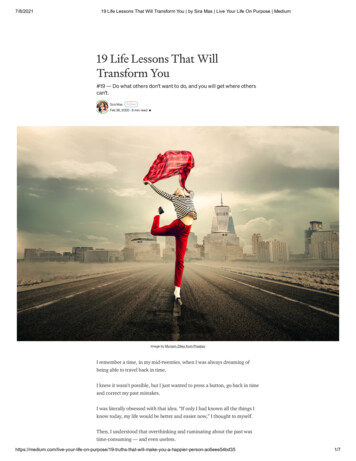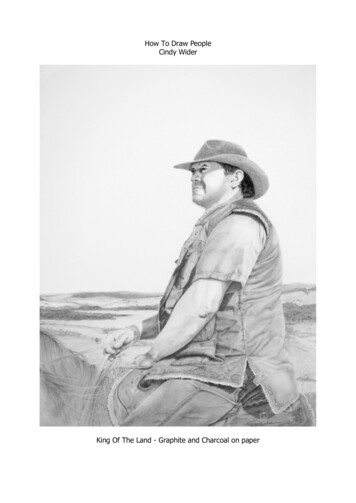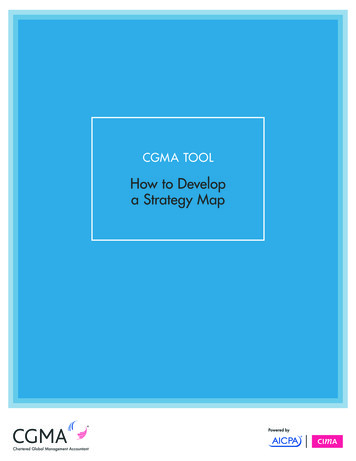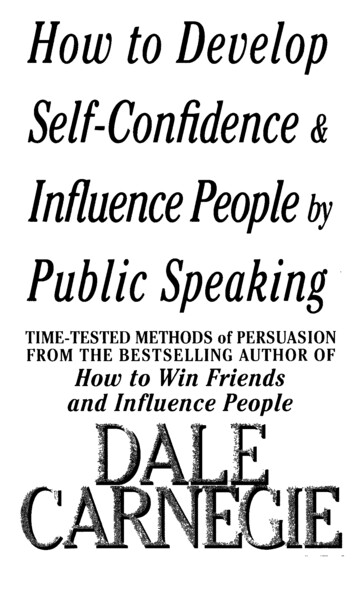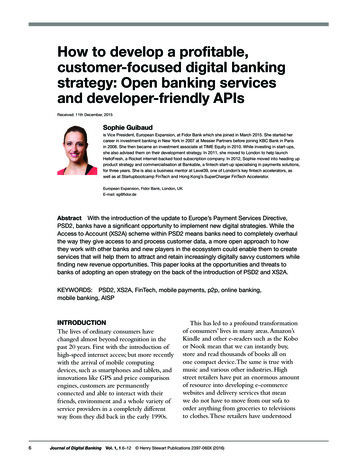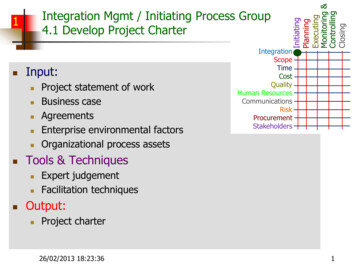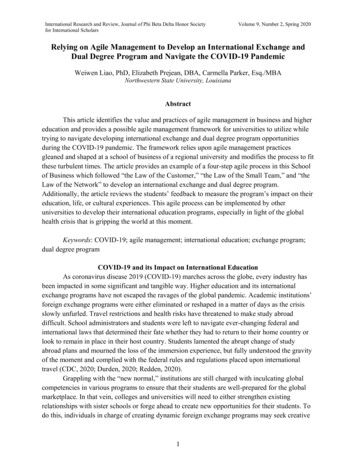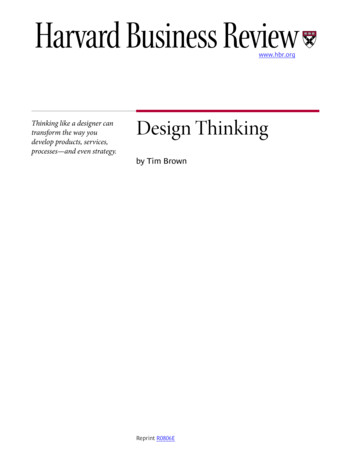
Transcription
www.hbr.orgThinking like a designer cantransform the way youdevelop products, services,processes—and even strategy.Design Thinkingby Tim BrownReprint R0806E
Thinking like a designer can transform the way you develop products,services, processes—and even strategy.Design Thinkingby Tim BrownCOPYRIGHT 2008 HARVARD BUSINESS SCHOOL PUBLISHING CORPORATION. ALL RIGHTS RESERVED.Thomas Edison created the electric lightbulband then wrapped an entire industry aroundit. The lightbulb is most often thought of as hissignature invention, but Edison understoodthat the bulb was little more than a parlortrick without a system of electric power generation and transmission to make it truly useful.So he created that, too.Thus Edison’s genius lay in his ability to conceive of a fully developed marketplace, notsimply a discrete device. He was able to envision how people would want to use what hemade, and he engineered toward that insight.He wasn’t always prescient (he originally believed the phonograph would be used mainlyas a business machine for recording and replaying dictation), but he invariably gave great consideration to users’ needs and preferences.Edison’s approach was an early example ofwhat is now called “design thinking”—a methodology that imbues the full spectrum of innovation activities with a human-centered designethos. By this I mean that innovation is powered by a thorough understanding, through di-harvard business review june 2008rect observation, of what people want andneed in their lives and what they like or dislikeabout the way particular products are made,packaged, marketed, sold, and supported.Many people believe that Edison’s greatestinvention was the modern R&D laboratoryand methods of experimental investigation.Edison wasn’t a narrowly specialized scientistbut a broad generalist with a shrewd businesssense. In his Menlo Park, New Jersey, laboratory he surrounded himself with gifted tinkerers, improvisers, and experimenters. Indeed,he broke the mold of the “lone genius inventor” by creating a team-based approach to innovation. Although Edison biographers writeof the camaraderie enjoyed by this merryband, the process also featured endlessrounds of trial and error—the “99% perspiration” in Edison’s famous definition of genius.His approach was intended not to validatepreconceived hypotheses but to help experimenters learn something new from each iterative stab. Innovation is hard work; Edisonmade it a profession that blended art, craft,page 1
Design Thinkingscience, business savvy, and an astute understanding of customers and markets.Design thinking is a lineal descendant ofthat tradition. Put simply, it is a disciplinethat uses the designer’s sensibility andmethods to match people’s needs with whatis technologically feasible and what a viablebusiness strategy can convert into customervalue and market opportunity. Like Edison’spainstaking innovation process, it often entails a great deal of perspiration.I believe that design thinking has much tooffer a business world in which most management ideas and best practices are freely available to be copied and exploited. Leaders nowlook to innovation as a principal source of differentiation and competitive advantage; theywould do well to incorporate design thinkinginto all phases of the process.Getting Beneath the SurfaceTim Brown (tbrown@ideo.com) is theCEO and president of IDEO, an innovation and design firm with headquartersin Palo Alto, California. His designs havewon numerous awards and been exhibited at the Museum of Modern Artin New York, the Axis Gallery in Tokyo,and the Design Museum in London.harvard business review june 2008Historically, design has been treated as adownstream step in the development process—the point where designers, who have playedno earlier role in the substantive work of innovation, come along and put a beautiful wrapper around the idea. To be sure, this approachhas stimulated market growth in many areasby making new products and technologiesaesthetically attractive and therefore more desirable to consumers or by enhancing brandperception through smart, evocative advertising and communication strategies. During thelatter half of the twentieth century design became an increasingly valuable competitiveasset in, for example, the consumer electronics, automotive, and consumer packagedgoods industries. But in most others it remained a late-stage add-on.Now, however, rather than asking designersto make an already developed idea more attractive to consumers, companies are askingthem to create ideas that better meet consumers’ needs and desires. The former role is tactical, and results in limited value creation; thelatter is strategic, and leads to dramatic newforms of value.Moreover, as economies in the developedworld shift from industrial manufacturing toknowledge work and service delivery, innovation’s terrain is expanding. Its objectives areno longer just physical products; they are newsorts of processes, services, IT-powered interactions, entertainments, and ways of commu-nicating and collaborating—exactly the kindsof human-centered activities in which designthinking can make a decisive difference. (Seethe sidebar “A Design Thinker’s PersonalityProfile.”)Consider the large health care provider Kaiser Permanente, which sought to improve theoverall quality of both patients’ and medicalpractitioners’ experiences. Businesses in theservice sector can often make significant innovations on the front lines of service creationand delivery. By teaching design thinking techniques to nurses, doctors, and administrators,Kaiser hoped to inspire its practitioners to contribute new ideas. Over the course of severalmonths Kaiser teams participated in workshops with the help of my firm, IDEO, and agroup of Kaiser coaches. These workshops ledto a portfolio of innovations, many of whichare being rolled out across the company.One of them—a project to reengineernursing-staff shift changes at four Kaiser hospitals—perfectly illustrates both the broadernature of innovation “products” and the valueof a holistic design approach. The core projectteam included a strategist (formerly a nurse),an organizational-development specialist, atechnology expert, a process designer, a unionrepresentative, and designers from IDEO. Thisgroup worked with innovation teams of frontline practitioners in each of the four hospitals.During the earliest phase of the project, thecore team collaborated with nurses to identifya number of problems in the way shift changesoccurred. Chief among these was the fact thatnurses routinely spent the first 45 minutes ofeach shift at the nurses’ station debriefing thedeparting shift about the status of patients.Their methods of information exchange weredifferent in every hospital, ranging from recorded dictation to face-to-face conversations.And they compiled the information theyneeded to serve patients in a variety of ways—scrawling quick notes on the back of any available scrap of paper, for example, or even ontheir scrubs. Despite a significant investmentof time, the nurses often failed to learn someof the things that mattered most to patients,such as how they had fared during the previousshift, which family members were with them,and whether or not certain tests or therapieshad been administered. For many patients, theteam learned, each shift change felt like a holein their care. Using the insights gleaned frompage 2
Design Thinkingobserving these important times of transition,the innovation teams explored potential solutions through brainstorming and rapid prototyping. (Prototypes of a service innovation willof course not be physical, but they must be tangible. Because pictures help us understandwhat is learned through prototyping, we oftenvideotape the performance of prototyped services, as we did at Kaiser.)Prototyping doesn’t have to be complex andexpensive. In another health care project,IDEO helped a group of surgeons develop anew device for sinus surgery. As the surgeonsdescribed the ideal physical characteristics ofthe instrument, one of the designers grabbeda whiteboard marker, a film canister, and aclothespin and taped them together. “Do youmean like this?” he asked. With his rudimentary prototype in hand, the surgeons were ableto be much more precise about what theultimate design should accomplish.Prototypes should command only as muchtime, effort, and investment as are needed togenerate useful feedback and evolve an idea.The more “finished” a prototype seems, theless likely its creators will be to pay attentionto and profit from feedback. The goal of prototyping isn’t to finish. It is to learn about thestrengths and weaknesses of the idea and toidentify new directions that further prototypes might take.The design that emerged for shift changeshad nurses passing on information in front ofthe patient rather than at the nurses’ station.In only a week the team built a working prototype that included new procedures and somesimple software with which nurses could callup previous shift-change notes and add newones. They could input patient informationthroughout a shift rather than scrambling atthe end to pass it on. The software collated thedata in a simple format customized for eachnurse at the start of a shift. The result was bothhigher-quality knowledge transfer and reducedprep time, permitting much earlier and betterinformed contact with patients.As Kaiser measured the impact of thischange over time, it learned that the mean interval between a nurse’s arrival and first interaction with a patient had been more thanhalved, adding a huge amount of nursing timeacross the four hospitals. Perhaps just as important was the effect on the quality of thenurses’ work experience. One nurse commented, “I’m an hour ahead, and I’ve onlybeen here 45 minutes.” Another said, “[This isthe] first time I’ve ever made it out of here atthe end of my shift.”Thus did a group of nurses significantlyimprove their patients’ experience while alsoimproving their own job satisfaction and productivity. By applying a human-centered design methodology, they were able to create arelatively small process innovation that produced an outsize impact. The new shiftchanges are being rolled out across the KaiserA Design Thinker’s Personality ProfileContrary to popular opinion, you don’t needweird shoes or a black turtleneck to be a design thinker. Nor are design thinkers necessarily created only by design schools, eventhough most professionals have had somekind of design training. My experience is thatmany people outside professional designhave a natural aptitude for design thinking,which the right development and experiences can unlock. Here, as a starting point,are some of the characteristics to look for indesign thinkers:Empathy. They can imagine the worldfrom multiple perspectives—those of colleagues, clients, end users, and customers(current and prospective). By taking a “people first” approach, design thinkers can imag-harvard business review june 2008ine solutions that are inherently desirableand meet explicit or latent needs. Great design thinkers observe the world in minute detail. They notice things that others do not anduse their insights to inspire innovation.Integrative thinking. They not only rely onanalytical processes (those that produce either/or choices) but also exhibit the ability to see allof the salient—and sometimes contradictory—aspects of a confounding problem and createnovel solutions that go beyond and dramaticallyimprove on existing alternatives. (See RogerMartin’s The Opposable Mind: How SuccessfulLeaders Win Through Integrative Thinking.)Optimism. They assume that no matterhow challenging the constraints of a givenproblem, at least one potential solution isbetter than the existing alternatives.Experimentalism. Significant innovationsdon’t come from incremental tweaks. Designthinkers pose questions and explore constraints in creative ways that proceed in entirely new directions.Collaboration. The increasing complexityof products, services, and experiences has replaced the myth of the lone creative geniuswith the reality of the enthusiastic interdisciplinary collaborator. The best design thinkersdon’t simply work alongside other disciplines;many of them have significant experience inmore than one. At IDEO we employ peoplewho are engineers and marketers, anthropologists and industrial designers, architects andpsychologists.page 3
Design Thinkingsystem, and the capacity to reliably recordcritical patient information is being integrated into an electronic medical records initiative at the company.What might happen at Kaiser if every nurse,doctor, and administrator in every hospital feltempowered to tackle problems the way thisgroup did? To find out, Kaiser has created theGarfield Innovation Center, which is run byKaiser’s original core team and acts as a consultancy to the entire organization. The center’smission is to pursue innovation that enhancesthe patient experience and, more broadly, toenvision Kaiser’s “hospital of the future.” It isintroducing tools for design thinking acrossthe Kaiser system.How Design Thinking HappensThe myth of creative genius is resilient: We believe that great ideas pop fully formed out ofbrilliant minds, in feats of imagination wellbeyond the abilities of mere mortals. But whatthe Kaiser nursing team accomplished was neither a sudden breakthrough nor the lightningstrike of genius; it was the result of hard workaugmented by a creative human-centered discovery process and followed by iterative cyclesof prototyping, testing, and refinement.The design process is best described metaphorically as a system of spaces rather than apredefined series of orderly steps. The spacesdemarcate different sorts of related activitiesthat together form the continuum of innovation. Design thinking can feel chaotic to thoseexperiencing it for the first time. But over thelife of a project participants come to see—asthey did at Kaiser—that the process makessense
team learned, each shift change felt like a hole in their care. Using the insights gleaned from Tim Brown (tbrown@ideo.com) is the CEO and president of IDEO, an innova-tion and design firm with headquarters in Palo Alto, California. His designs have won numerous awards

